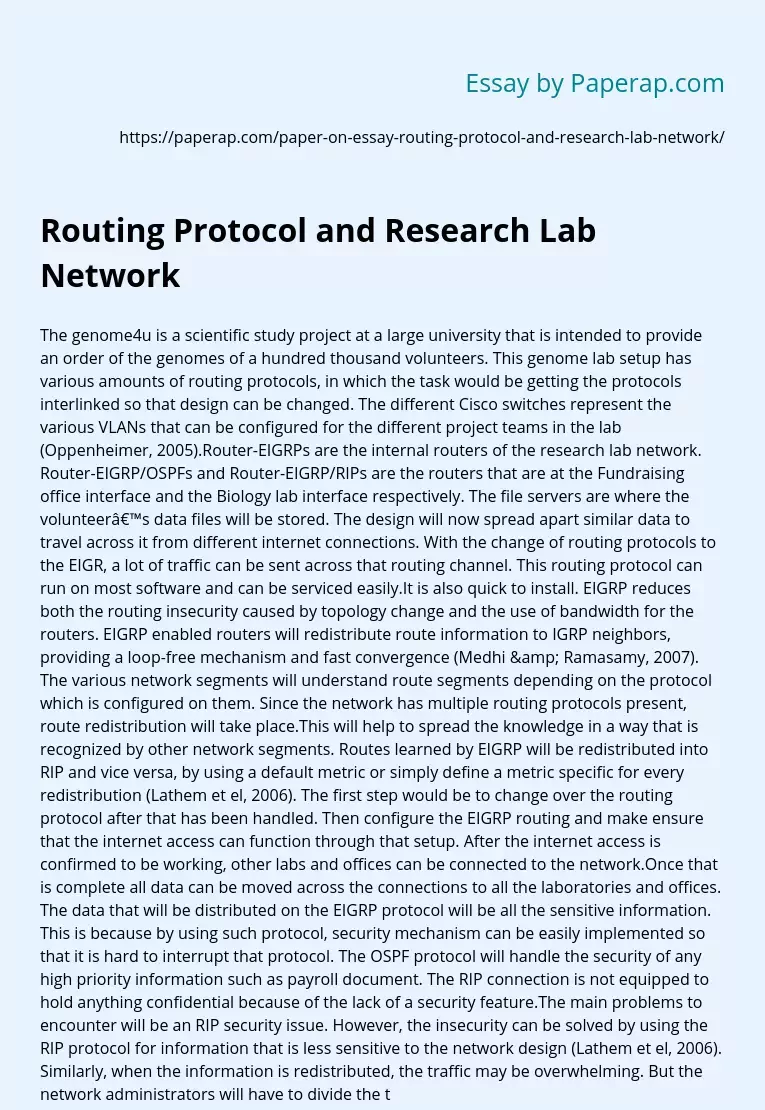Routing Protocol and Research Lab Network
The genome4u is a scientific study project at a large university that is intended to provide an order of the genomes of a hundred thousand volunteers. This genome lab setup has various amounts of routing protocols, in which the task would be getting the protocols interlinked so that design can be changed. The different Cisco switches represent the various VLANs that can be configured for the different project teams in the lab (Oppenheimer, 2005).
Router-EIGRPs are the internal routers of the research lab network.
Router-EIGRP/OSPFs and Router-EIGRP/RIPs are the routers that are at the Fundraising office interface and the Biology lab interface respectively. The file servers are where the volunteer’s data files will be stored. The design will now spread apart similar data to travel across it from different internet connections. With the change of routing protocols to the EIGR, a lot of traffic can be sent across that routing channel. This routing protocol can run on most software and can be serviced easily.
It is also quick to install. EIGRP reduces both the routing insecurity caused by topology change and the use of bandwidth for the routers. EIGRP enabled routers will redistribute route information to IGRP neighbors, providing a loop-free mechanism and fast convergence (Medhi & Ramasamy, 2007). The various network segments will understand route segments depending on the protocol which is configured on them. Since the network has multiple routing protocols present, route redistribution will take place. This will help to spread the knowledge in a way that is recognized by other network segments.
Routes learned by EIGRP will be redistributed into RIP and vice versa, by using a default metric or simply define a metric specific for every redistribution (Lathem et el, 2006).
The first step would be to change over the routing protocol after that has been handled. Then configure the EIGRP routing and make ensure that the internet access can function through that setup. After the internet access is confirmed to be working, other labs and offices can be connected to the network.Once that is complete all data can be moved across the connections to all the laboratories and offices. The data that will be distributed on the EIGRP protocol will be all the sensitive information. This is because by using such protocol, security mechanism can be easily implemented so that it is hard to interrupt that protocol.
The OSPF protocol will handle the security of any high priority information such as payroll document. The RIP connection is not equipped to hold anything confidential because of the lack of a security feature.The main problems to encounter will be an RIP security issue. However, the insecurity can be solved by using the RIP protocol for information that is less sensitive to the network design (Lathem et el, 2006).
Similarly, when the information is redistributed, the traffic may be overwhelming. But the network administrators will have to divide the traffic so that all the routers can each carry their weight of the information.
The problems with the flow of traffic will be fixed and distributed through the routers. Each router will be used for certain information and that way the routers will not be overworked. Also the security will be set up so that all confidential information goes through those securities enabled routing protocol. Internet will be purchased internet from the best vendor nearby like Verizon. In the design a router will be installed in each office and lab, then configure them to operate on the network with appropriate security configuration. Finally, the internet connection would come from those routers and all the labs and offices would run on that service.
Routing Protocol and Research Lab Network. (2018, Jun 10). Retrieved from https://paperap.com/paper-on-essay-routing-protocol-and-research-lab-network/

